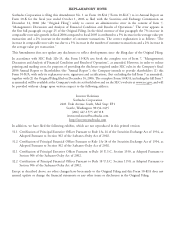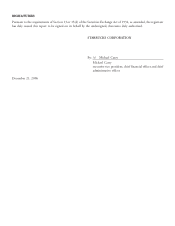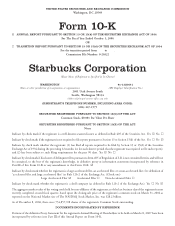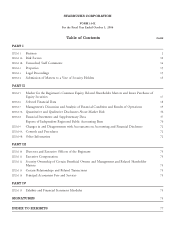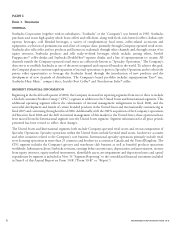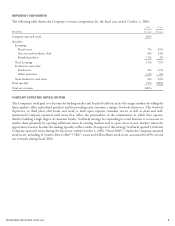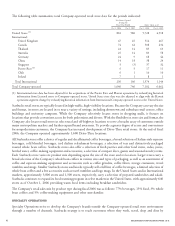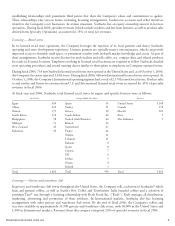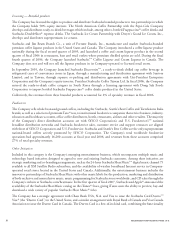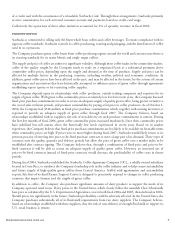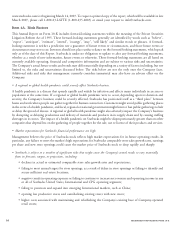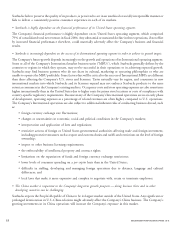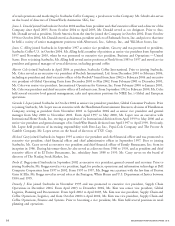Starbucks 2006 Annual Report Download - page 12
Download and view the complete annual report
Please find page 12 of the 2006 Starbucks annual report below. You can navigate through the pages in the report by either clicking on the pages listed below, or by using the keyword search tool below to find specific information within the annual report.The Company also purchases a broad range of paper and plastic products, such as cups, lids, napkins, straws, shopping
bags and corrugated paper boxes from several companies to support the needs of its retail stores as well as its
manufacturing and distribution operations. The cost of these materials is dependent in part upon commodity paper
and plastic resin costs, but the Company believes it mitigates the effect of short-term raw material price fluctuations
through strategic relationships with key suppliers. In the United States, the Company is contractually required to
purchase all of its cups, lids, straws and cutlery from a single supplier. Any material interruption in the supply of these
products to the Company, if not offset by sufficient purchases from other suppliers, could materially adversely affect the
Company’s supply chain and its ability to serve its U.S. retail customers. The Company believes, based on its relationship
with this supplier, that the risk of non-delivery of enough of these products to support its U.S. retail business is remote.
Products other than whole bean coffees and coffee beverages sold in Starbucks retail stores are obtained through a number
of different channels. Beverage ingredients, other than coffee and milk, including leaf teas and the Company’s menu of
ready-to-drink beverages, are purchased from several specialty manufacturers, usually under long-term supply contracts.
Food products, such as fresh pastries and lunch items, are generally purchased from both regional and local sources.
Coffee-making equipment, such as drip and French press coffeemakers, espresso machines and coffee grinders, are
generally purchased directly from their manufacturers. Coffee-related accessories, including items bearing the Company’s
logos and trademarks, are produced and distributed through contracts with a number of different suppliers.
COMPETITION
The Company’s primary competitors for coffee beverage sales are restaurants, specialty coffee shops and doughnut shops.
In almost all markets in which the Company does business, there are numerous competitors in the specialty coffee
beverage business, and management expects this situation to continue. Although competition in the beverage market is
currently fragmented, competition is increasing, particularly from competitors in the quick-service restaurant sector who
are focusing on growing the specialty coffee part of their business. A major competitor with substantially greater financial,
marketing and operating resources than the Company could enter this market at any time and compete directly against
Starbucks.
The Company’s whole bean coffees compete directly against specialty coffees sold through supermarkets, specialty
retailers and a growing number of specialty coffee stores. Both the Company’s whole bean coffees and its coffee beverages
compete indirectly against all other coffees on the market. The Company believes that its customers choose among
retailers primarily on the basis of product quality, service and convenience, and, to a lesser extent, on price.
Starbucks believes that supermarkets are the most competitive distribution channel for specialty whole bean coffee, in part
because supermarkets offer customers a variety of choices without having to make a separate trip to a specialty coffee store.
A number of coffee manufacturers are distributing premium coffee products in supermarkets. Regional specialty coffee
companies also sell whole bean coffees in supermarkets.
In addition to the competition generated by supermarket sales of coffee, Starbucks competes for whole bean coffee sales
with franchise operators and independent specialty coffee stores. In virtually every major metropolitan area where
Starbucks operates and expects to expand, there are local or regional competitors with substantial market presence in the
specialty coffee business. Starbucks Specialty Operations also face significant competition from established wholesale and
mail order suppliers, some of whom have greater financial and marketing resources than the Company.
Starbucks faces intense competition from both restaurants and other specialty retailers for suitable sites for new stores and
qualified personnel to operate both new and existing stores. There can be no assurance that Starbucks will be able to
continue to secure adequate sites at acceptable rent levels or that the Company will be able to attract a sufficient number
of qualified personnel.
PATENTS, TRADEMARKS, COPYRIGHTS AND DOMAIN NAMES
The Company owns and/or has applied to register numerous trademarks and service marks in the United States and in
nearly 180 additional countries throughout the world. Rights to the trademarks and service marks in the United
8STARBUCKS CORPORATION, FORM 10-K


